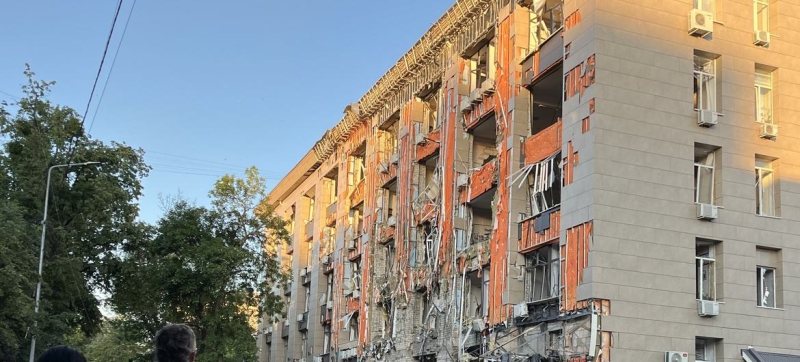
Consequences of a strike on a residential area of Kharkov on May 25. The UN announced new data on the number of victims in Ukraine Humanitarian aid
The number of civilian casualties in Ukraine continues to rise. At least 174 civilians were killed and 690 injured in May, according to the UN Human Rights Monitoring Mission in Ukraine. This is the highest number of civilian casualties in one month since June 2023. More than half of these victims occur in the Kharkov region.
Joyce Msuya, assistant to the UN chief for humanitarian affairs, spoke about this at a briefing at the UN Security Council on the humanitarian situation in Ukraine. She noted that shopping centers, residential buildings, educational institutions, shops, office buildings, parks and public transport have been hit in recent weeks.
In the Kharkov region there are more than 18 thousand displaced people
“According to the International Organization for Migration, at least 18,100 people in the Kharkov region have become internally displaced. With the support of about 50 humanitarian organizations, more than 12,000 people are receiving assistance at the transit center in Kharkov. This includes food, water, clothing, bedding, household items, cash, psychosocial support and legal assistance,” says Msuya.
Civilians who remain in the border and front-line areas of Kharkov are in difficult conditions. Many of them do not have access to food, medical care, electricity and gas.
Older people suffer the most as they are often unable or unwilling to leave their homes. In the north of the Kharkov region, where the most intense fighting is taking place, more than half of those killed and wounded are people over 60 years old.
The monitoring mission confirmed that since February 24, 2022, at least At least 11,000 civilians were killed and 21,000 civilians were injured throughout Ukraine. Actual losses are probably much higher.
Anniversary of the Kakhovka disaster
“A year has passed since the disaster at the Kakhovka Dam – one of the most significant incidents affecting civilian infrastructure since the beginning of the full-scale invasion. The destruction of the dam caused large-scale flooding, as a result of which most of the surrounding area was under water. Homes were destroyed, families were displaced, millions of people were left without livelihoods and water supplies,” Msuya recalled.
This case showed how large-scale and long-term the humanitarian consequences of one incident affecting critical infrastructure can be, the Assistant Secretary General emphasized.
Attacks on Energy Infrastructure
“This is why it is deeply concerning that systematic attacks on Ukraine’s energy infrastructure have been a feature of this war since February 2022 years – ongoing.
Since March 22, 2024, the UN and its partners have recorded six waves of such attacks in 15 regions. As a result, healthcare, social, payment and transport systems were affected, as well as the supply of electricity, gas and water, which affected millions of families.
According to preliminary estimates by the United Nations Development Program, based on official data, the generating capacity of Ukraine’s energy system has fallen by more than 60 percent compared to pre-war capacity.
Strikes on transport and port infrastructure
“We are also deeply concerned about the impact of attacks on Ukraine’s transport and port infrastructure on global food security “Msuya said.
In recent weeks, there have been worrying signs that global grain prices will rise. This is due, among other things, to the damage caused to the infrastructure in Ukraine, noted the Assistant Secretary General.
She stated the need to ensure safe navigation throughout the Black Sea and protecting ports and related civilian infrastructure so that food exports can flow predictably and efficiently into world markets.
Strikes on Russian territory
Msuya also noted strikes on Russian territory in recent months, including in the Belgorod region, which also led to civilian casualties and damage to residential buildings and other civilian infrastructure.
Humanitarian needs of the population
The scale of humanitarian needs in Ukraine remains enormous, said an assistant to the UN chief. More than 14.6 million people – about 40 percent of the population – require some form of humanitarian assistance. More than half of them are women and girls.
“We are incredibly grateful to donors who have provided $856 million in humanitarian funding to date – or 27 percent of the $3.1 billion needed under the 2024 Humanitarian Needs and Response Plan,” Msuya said.
“This funding enabled nearly 500 humanitarian organizations (about 70 percent of them national organizations, including local women-led organizations) to assist more than 4 million people in the first four months this year,” she added.
At the same time, Msuya noted the lack of humanitarian access to approximately 1.5 million civilians in Donetsk, Lugansk, Kherson and Zaporozhye areas that are currently under occupation by the Russian Federation.
“I am forced to remind once again that all parties must respect international humanitarian law, including facilitate the provision of humanitarian assistance to civilians in need and maintain at all times the protection of all civilians, as well as civilian objects, including homes, schools, hospitals and other critical infrastructure,” she said.
“We continue to call on the Security Council and all UN Member States to do everything in their power to enforce the rules of war, achieve peace and end the suffering of the Ukrainian people,” Msuya concluded.   ;
Read also:
